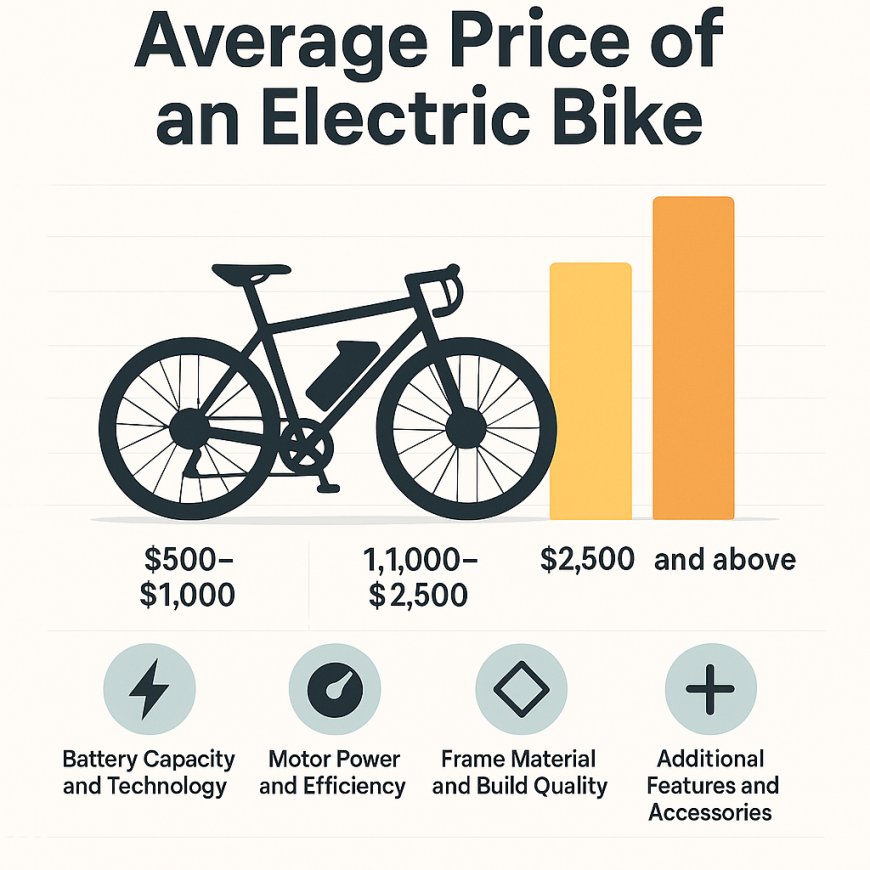Average Price of an Electric Bike
Electric bikes (e‑bikes) have surged in popularity over the past few years, offering an eco-friendly alternative to cars and a fun way to get around. But one question pops up more often than any other: “How much will I actually pay?”

Electric bikes (e‑bikes) have surged in popularity over the past few years, offering an eco friendly alternative to cars and a fun way to get around. But one question pops up more often than any other: “How much will I actually pay?” Let’s dive into the nitty‑gritty of e‑bike pricing so you can shop with confidence.
Introduction: Why Price Matters
When you’re first peeking at e‑bike listings online, prices can feel all over the place—from just a few hundred dollars to north of $5,000. Why such a wide gap? Your budget ultimately dictates what features, range, and performance you’ll get. Understanding average price points helps you set realistic expectations and avoid overspending on bells and whistles you don’t need.
Key Factors Influencing Electric Bike Prices
Battery Capacity and Technology
The battery is the heart of an e‑bike. Higher capacity lithium‑ion packs (measured in watt hours, Wh) provide longer range but cost more to produce. A 250 Wh battery might push a budget e‑bike around 20 miles on a single charge, whereas a 750 Wh pack on a premium model can go 60+ miles. Cutting‑edge battery management systems and fast‑charging capabilities also drive up costs.
Motor Power and Efficiency
E‑bike motors come in rear‑hub, mid‑drive, or front‑hub configurations. Mid‑drive motors often offer smoother power delivery and better hill‑climbing but require complex installation and calibration—reflected in a higher price tag. Motor wattage (250 W to 750 W and beyond) affects acceleration and top speed; more powerful options can cost several hundred dollars extra.
Frame Material and Build Quality
An aluminum frame is standard on most e‑bikes, balancing strength and weight. Higher‑end models may use carbon fiber or hydroformed aluminum for lighter weight and improved ride quality. Premium welds, integrated cable routing, and built‑in racks or fenders add to manufacturing complexity and thus to cost.
Additional Features and Accessories
From integrated lights and displays to hydraulic disc brakes, suspension forks, and smartphone connectivity—every extra feature tacks on production costs. A simple commuter e‑bike with mechanical brakes and a basic LCD might start at $800, while a fully loaded touring model with GPS, Shimano Deore drivetrain, and dual‑suspension can run beyond $3,000.
Price Ranges for Electric Bikes
Understanding broad price tiers helps you align price with desired features.
Budget Friendly Models ($500–$1,000)
These entry‑level e‑bikes cover essentials—smaller battery (250–400 Wh), basic steel or aluminum frame, and simple components.
Pros and Cons
-
Pros: Affordable way to test if you love e‑bikes; good for short commutes.
-
Cons: Limited range, heavier weight, basic ride quality.
Mid Range Models ($1,000–$2,500)
Here you get better battery capacity (400–600 Wh), more durable frames, upgraded brakes, and perhaps a mid‑drive motor.
Pros and Cons
-
Pros: Balanced performance and price; 30–50 miles per charge; better component longevity.
-
Cons: Still not top‑tier components; some weight trade‑offs.
Premium Models ($2,500 and Above)
These often showcase the best battery tech, lightweight materials (carbon fiber frames), top‑of‑the‑line Shimano or Bosch systems, and luxury add‑ons.
Pros and Cons
-
Pros: Exceptional range, performance, and durability; advanced features.
-
Cons: Steep investment; overkill for casual riders.
Types of Electric Bikes and Their Typical Costs
Commuter and City E‑Bikes
Designed for daily city use: fenders, racks, upright seating. Prices range $1,000–$2,500.
Mountain E‑Bikes
Built for rugged trails: suspension forks, wider tires. Expect $1,500–$6,000.
Folding E‑Bikes
Portable convenience for multi‑modal commuters. Usually $800–$1,800.
Cargo and Utility E‑Bikes
Heavy‑duty frames with carrying capacity—$1,500–$4,000.
New vs. Used Electric Bikes: Cost Considerations
Buying used can save 20–40%, but battery health and warranty status are big variables. A two‑year‑old e‑bike might list for $1,200 on resale platforms but could need a battery replacement at around $400.
Hidden Costs Beyond Sticker Price
Maintenance and Repairs
Routine tune‑ups run $50–$100. Brake pad or tire replacements are $20–$50 each. Mid‑drive motor servicing can hit $150 if done by a dealer.
Charging and Electricity Costs
Average electricity cost in the U.S. is about $0.15 kWh. Charging a 500 Wh battery costs roughly $0.075—so even daily charging for a month is under $3.
Insurance and Registration
Some locales require e‑bike registration; costs vary $10–$30 annually. Insurance or theft protection plans add $50–$150 per year.
Tips to Find the Best Value Electric Bike
Seasonal Sales and Discounts
Look around end of season sales (late fall) or holiday deals (Black Friday) for discounts up to 20%.
Financing and Lease Options
Many brands offer 0% APR financing for 6–12 months. Leasing can also spread cost but may require good credit.
Local vs. Online Dealers
Local bike shops provide test rides, fitting services, and post‑sale support—often worth the slight markup compared to online only retailers.
How to Evaluate Total Cost of Ownership
Add up purchase price, expected maintenance, electricity, and any accessories you’ll want (lock, helmet, lights). Compare that to your current commuting costs—gas, parking, public transport—to see when your e‑bike “pays for itself.”
Real World Examples: What People Actually Pay
-
Commuter Joe buys a $1,200 mid‑range e‑bike and spends ~$100/year on upkeep. He estimates payback in 2 years by ditching his car for short trips.
-
Trail Tina invests $4,500 in a high‑end mountain e‑bike, riding on weekends. She views it as a long‑term lifestyle purchase, not a commute cost‑saver.
Conclusion
E‑bikes offer incredible value once you match features to your needs. By understanding the factors that drive price—battery, motor, build quality—you can confidently pick a model that balances cost with performance. Remember to factor in hidden costs like maintenance and charging, and shop smart with sales or financing. With the right research, your ideal e‑bike is within reach and can transform your daily ride!
FAQs
-
What is the average cost of a good quality electric bike?
Generally, expect to pay between $1,000 and $2,500 for a reliable mid‑range model with decent battery life and components. -
Can I find an electric bike under $500?
Very few reputable models exist under $500; these often have limited range, basic parts, and may lack warranty coverage.
How long do e‑bike batteries last before replacement?
Most lithium‑ion batteries retain good capacity for 500 1,000 full charge cycles, translating to 2-4 years of typical use.
-
Are used electric bikes worth it?
Used e‑bikes can be a bargain if the seller can confirm battery health and the bike has been well maintained. Always test‑ride and inspect first. -
What maintenance should I budget for annually?
Plan on $100–$200 per year for tune‑ups, brake or tire replacements, and minor adjustments.









































